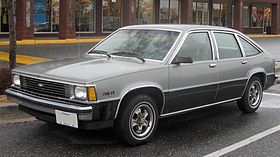| GM X platform (FWD) | |
|---|---|
 | |
| Overview | |
| Manufacturer | General Motors |
| Also called | X-body |
| Production | 1979–1985 |
| Body and chassis | |
| Class | Compact |
| Layout | Front engine, front-wheel drive |
| Body style(s) | 2-door notchback coupé 3-door hatchback 4-door notchback sedan 5-door hatchback |
| Vehicles | Chevrolet Citation Oldsmobile Omega Pontiac Phoenix Buick Skylark |
| Related | GM A platform (FWD) |
| Powertrain | |
| Engine(s) | |
| Transmission(s) | 3-speed TH 125 automatic 4-speed manual |
| Dimensions | |
| Wheelbase | 104.9 in (2,664 mm) |
| Chronology | |
| Predecessor | GM X platform (RWD) |
| Successor | GM N platform GM L platform |
The General Motors front-wheel drive X platform was used for compact cars from the 1980 through 1985 model years, superseding the earlier, similarly designated, rear-drive platform.
After front-wheel drive cars had become somewhat common in the North American market, first through foreign imports, and then by American-badged but wholly or partially foreign-developed cars (e.g., the Ford Fiesta and Dodge Omni), GM's X-bodies were the first American-developed front-wheel drive cars introduced for the high-volume, mainstream market. GM would subsequently migrate most of its mainstream platforms to front-wheel drive as well.
Where numerous earlier American front-wheel drive cars were aimed at the luxury market and manufactured in relatively small numbers, the GM X bodies offered an alternative to high volume imported front-wheel drive compacts — and initially met considerable sales success.
Ultimately, the X-bodies — which included the 1980–1985 Chevrolet Citation, 1980–1984 Oldsmobile Omega, 1980–1984 Pontiac Phoenix and 1980–1985 Buick Skylark — became synonymous with their design defects, and GM's mishandled response.[1]
The X platform was the basis for the intermediate FWD GM A-body that proved much more successful. The X platform was superseded by the L-body and N-body platforms, which were derived from the J-body platform.